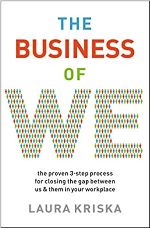BOOK REVIEW
 Book Title: The Business of We
Book Title: The Business of We
Author: Laura Kriska
Publisher: Harper Collins Leadership
List Price: $19.99
Format: Softcover, 290 pages
Publication Date: January 2021
ISBN: 978-1400216802
Reviewer: Dr. Marjorie Anne Fox
Review Date: August 2021
Introduction
This book is a powerful and timely argument for institutions to re-examine their corporate culture, and in many cases to make fundamental changes. It offers a system called WE-building as a solution to what the author calls Us versus Them gaps that are caused by identity-based cultural differences.
Many companies now have programs and policies designed to recruit diverse individuals, to train people from diverse backgrounds to work together and to prohibit discrimination. Unfortunately, implementation often falls short because the programs are superficial, reactive, and not effective. Despite the programs, most organizations still lack a diverse and inclusive workforce. Many organizations still approach diversity by reacting to complaints, lawsuits, and negative publicity instead of proactively working to institute a culture of diversity, equality and inclusion.
Overview of Book’s Structure
The book is divided into three sections. Section one defines and explores the challenge facing institutions today. Is diversity viewed as a problem to be solved or as a valuable resource that can be leveraged for success? The ‘problem’ approach creates Us versus Them gaps. There is typically a homogenous group in power (historically white and male) which Ms. Kriska calls the ‘Home Team.’ People who want to succeed in an organization (and be part of Us) are required to conform to the norms of the home team. People with different norms are categorized as Them and are often marginalized and excluded. The ‘valuable resource’ approach seeks to close gaps by creating a culture of equality and inclusion through WE-building.
Section two explains the process of using WE-building to close Us versus Them gaps. The three steps of the process are: fostering awareness, self-assessment and taking action. Everyone must become aware that the definition of normal behavior differs across cultures. The particular gaps affecting the team or company must be identified. Awareness involves the accumulation of facts and firsthand experiences that include both visible and invisible data. The data are regarded as being like an iceberg. A few items (such as language, clothing, and food) are easily visible, but there are a host of assumptions, values, and beliefs beneath the surface. The invisible data are usually critical in determining norms.
Once awareness is established, the team should complete the self-assessment instrument, a set of ten questions that have yes or no answers. Each participant takes the assessment privately, and scores themself by adding up the number of yes answers. Those with higher scores are less likely to have problems interacting with people from other cultures. Results for the group are collected anonymously and evaluated. The assessment provides valuable feedback for selecting action plans to bridge the gap and for redrawing the lines of belonging so that more people become part of Us…
More…
To read entire Book Review, click here
How to cite this book review: Fox, M.A. (2021). The Business of WE, book review, PM World Journal, Vol. X, Issue IX, September. Available online at: https://pmworldlibrary.net/wp-content/uploads/2021/09/pmwj109-Sep2021-Fox-The-Business-of-We-book-review.pdf
About the Reviewer

Dr. Marjorie Anne Fox
Texas, USA
![]()
Dr. Marjorie Anne Fox has more than 20 years of experience in practicing and teaching strategy and project management. She has served as the strategy lead for Aveda Corporation’s largest distributor, taught at several major universities, and assisted numerous consulting clients. She is a lifelong advocate of diversity, equality, and inclusion. A respect for cultural differences is at the heart of everything she does. She received her PhD and MBA from Tulane University, and her bachelor’s degree from the University of Maryland. She is CAPM certified by the Project Management Institute (PMI). Dr. Fox can be contacted at mfox@fastmail.com
Editor’s note: This book review was the result of a partnership between the publisher, PM World and the PMI Alamo Chapter. Authors and publishers offer the books to PM World; books are delivered to the PMI Alamo Chapter, where they are offered free to PMI members to review; book reviews are published in the PM World Journal and PM World Library. PMI Alamo Chapter members can keep the books as well as claim PDUs for PMP recertification when their reviews are published.
If you have read a good recently published book related to managing programs, projects or teams of professionals, consider authoring a book review for publication in the PM World Journal. For our standard format or for more information, contact Editor@pmworldjournal.com or visit https://pmworldlibrary.net/book-review-program/
If you are an author or publisher of a project management-related book, and would like the book reviewed through this program, please contact Editor@pmworldjournal.com.









